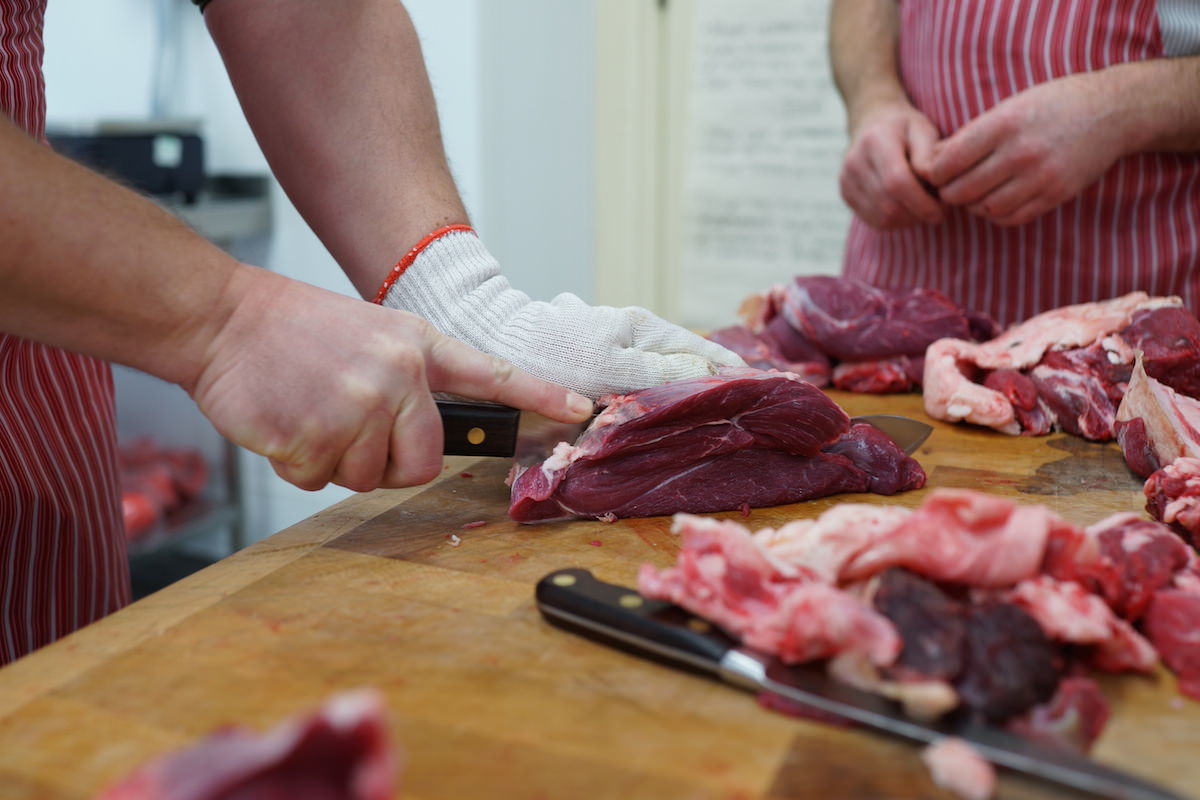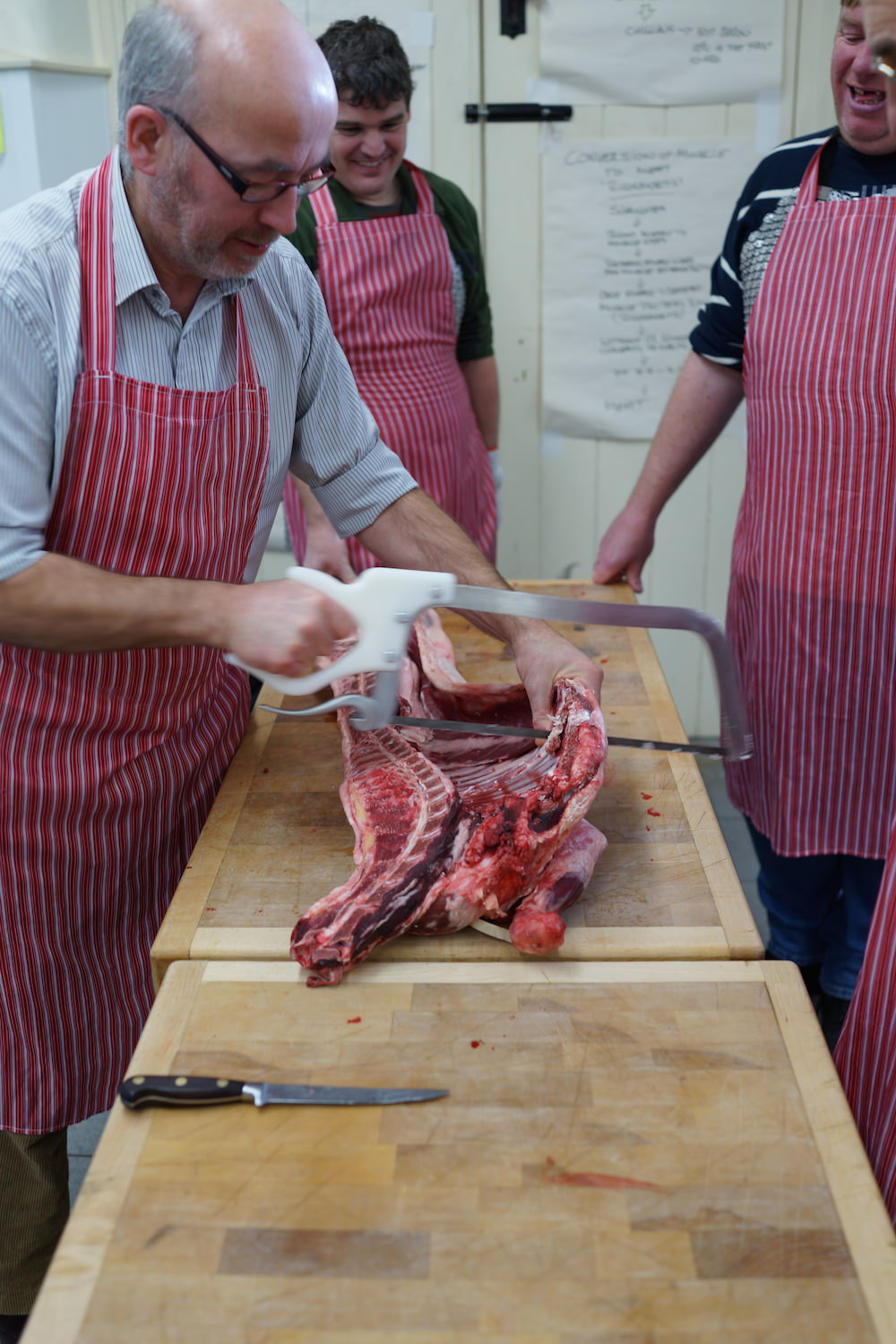Day 1 – Monday 24th November
Arriving at The School of Artisan Food on the Welbeck Estate set in the Sherwood Forest.
Introductions
After a quick coffee and croissant with my 3 classmates and our tutor Andrew ‘Farmer’ Sharp, we each did a quick introduction, explaining our level of experience in butchery and what we hoped to learn by doing the course. As a total beginner I was relieved to learn that whilst the others (an ex forces chef, ex farmer and farm shop owner and a IT consultant with a passion for meat) had all done some prior butchery Andrew assured me we’d all get plenty of practice cutting up both beef, lamb and mutton over the duration of the two days and also discuss the influence of breed, feed, slaughter and ageing.
Tools of the Trade
Andrew took us through the different types of knives and sharpening tools – advocating that we each get a good quality sharpening stone and steel.
Breed Selection
Andrew ran through the various cattle and sheep breeds on a Farmers Weekly Wall Chart – we discussed the characteristics of both native and continental breeds in the context of eating quality. Traditionally supermarkets and some butchers have favoured larger continental cattle such as Limousine, Belgian Blue and Charolais beasts which have huge frames, take a lot of fattening (require a high amount of inputs – compounds and cereals) and kill out with very little fat, providing a better killing out ratio (live weight to dead weight carcasses). The majority of conventional livestock farmers service this demand, focusing on yield whilst for the most part being price takers, chiefly determined by global prices and supermarket grading schemes.
The good news is the tide is turning with a growing niche of farmers taking advantage of a demand for native breed meat and ‘direct from the farm’ provenance, by supplying the home market direct via farm shops, box schemes and online. Native breed cattle also require less inputs; are smaller, slower growing and fattier, helping farmers realise a higher margin by cutting out the middleman and build a customer base of consumers who want tastier, healthier high quality meat.
Dexter Beast
We started our practical introduction to butchery with a Dexter veal beast which was slaughtered at around 4 months old with Andrew explaining that every carcass can be traced (via it’s passport) back from the farm where it is born up until the day it is slaughtered.
This particular beast was slaughtered in Thirsk and came from a specialist rare and traditional breeds meat producer based in North Yorkshire.
After a few pointers from Andrew we soon got to have a go ourselves..

Lunchtime and we got to sample some of fare cooked in the kitchen of the cookery school of the year…
After a superb lunch we got back down to business and each took it in turn to use the knife under the guidance of Andrew.
With the least amount of experience among my peers, Andrew kindly gave me the less challenging tasks but whilst trimming out I accidentally managed to cut into the fillet but soon wised up when Andrew quoted the going rate for fillet of beef
By the end of the afternoon I was physically and mentally exhausted and ready for a good nights sleep. Grabbing a lift from one of my classmates I made my way to the local Browns of Holbeck B&B less than a mile away from the school and run by Joan and Robin Brown. I was warmly greeted by Joan who showed me to my room, took my breakfast order and after watching a bit of TV in my four poster bed it wasn’t long before I was fast asleep!
Day 2 – Tuesday 25th November
After a hearty Eggs Benedict breakfast I caught a lift back to school for a 9am start covering some more theory before donning our chain-mail and red aprons to finish cutting up the Dexter beast.


Rolling Meat Joints
Andrew demonstrated how to roll and tie up joints – we then all got to have a go.
Here’s one I made earlier..
Grading
Having finished cutting up the Dexter Beast we stopped for a coffee break and then Andrew talked us through an ‘industry’ EBLEX chart with a scale of how carcasses are graded in slaughterhouses.
Texel cross lamb
Our second carcass was a Texel cross lamb and we started by examining the fat content on the cross section.
Weighing the carcass..
Marking up the lamb before sawing..
French trimming the rack..
Lunchtime..
Post lunch cheese and pickles (made on the estate)..
And back to work..
Presentation
We discussed the importance of presentation in artisan butchery and Andrew demonstrated a number of useful techniques to prepare and trim out valuable cuts such as the french trimmed shank..

Herdwick Mutton
As a founding member of the Mutton rennaisance campaign Andrew had chosen a Herdwick Ewe as our third and final carcass to butcher – approximately 5 years old, the meat had a lovely dark red hue. He suggested he would have preferred to see slightly more fat on the carcass requiring a bit more finish on the ewe before it was sent for slaughter but nevertheless assured us it would still taste amazing.
The carcass had been hung in a cold room for about a month
The widely held perception of mutton is you need to slow cook it, but keen to show us a different side to the meat, we.pan fried it instead..
Tasting the meat I was blown away by the flavour and tenderness of the meat. It was then that Andrew recounted a similar tasting he carried out with some of the top Italian chefs at Slow Food’s annual Salone de Gusto who haled the meat some of the best they had tasted.
Wrapping up the two day course we said our farewells and I caught a taxi back to Retford station. Heading back to the farm on the train I felt excited about my new butchery knowledge and a lot more confident about my plan to sell our own meat direct to customers..
More Information
For more information and details on future Advanced Meat course dates click HERE
Useful resources
EBLEX’s meat purchasing guide app


































